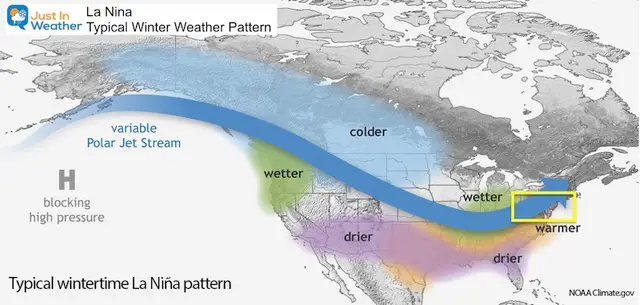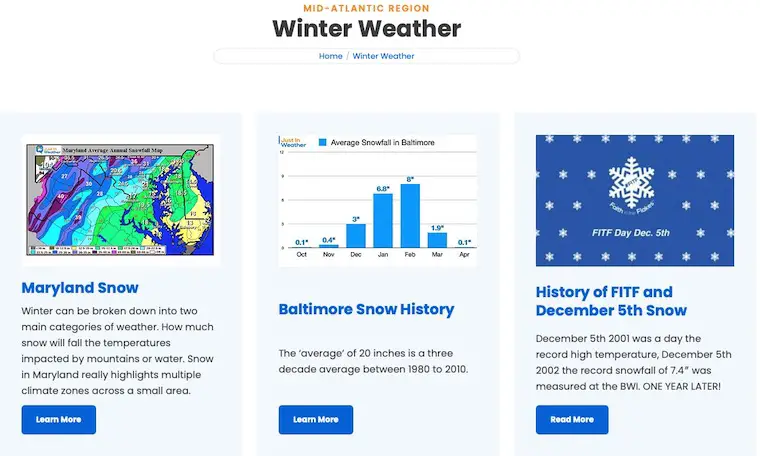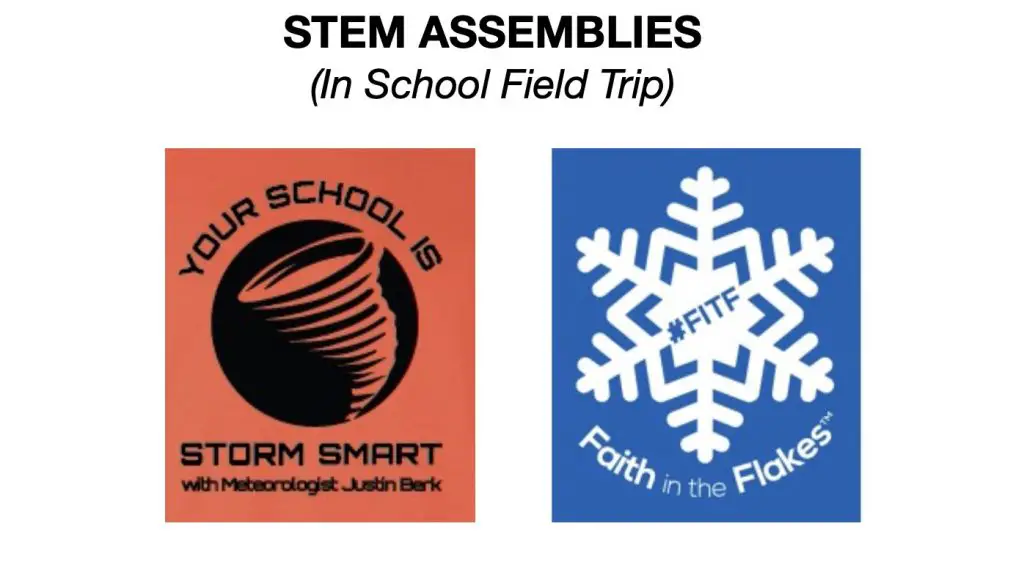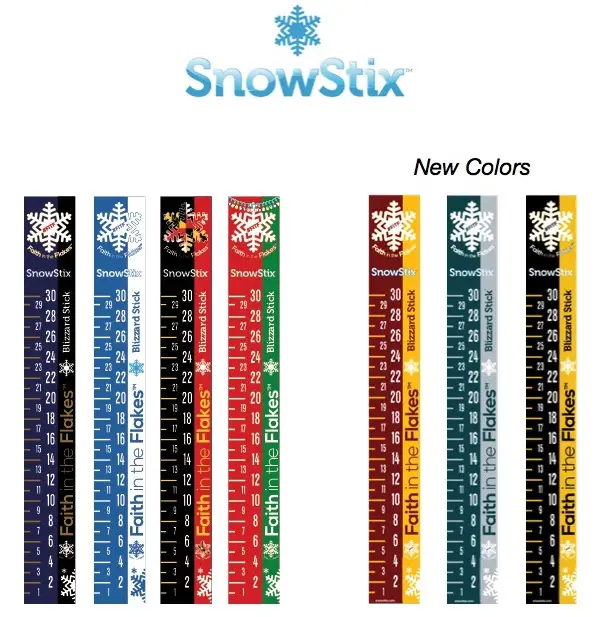September 9, 2022
We are in a La Niña Advisory and it is favored to continue through the upcoming winter. This would be a rare third winter in a row for this colder water phenomenon in the Pacific Ocean which can have a big impact on the winter weather across North America. This includes everything from snow to tornado outbreaks. According to the World Meteorological Organization, it is also being credited for mitigating or cooling global temperatures.
“It is exceptional to have three consecutive years with a la Niña event. Its cooling influence is temporarily slowing the rise in global temperatures – but it will not halt or reverse the long-term warming trend,” Petteri Taalas, the secretary-general of WMO, said in a recent report.
ENSO Alert System: La Niña Advisory
The El Niño and Southern Oscillation (ENSO) is monitored by NOAA’s Climate Prediction Center, National Center for Environmental Prediction, and National Weather Service.
La Niña is the colder phase. El Niño is the warmer phase. They often cycle through every three to seven years.
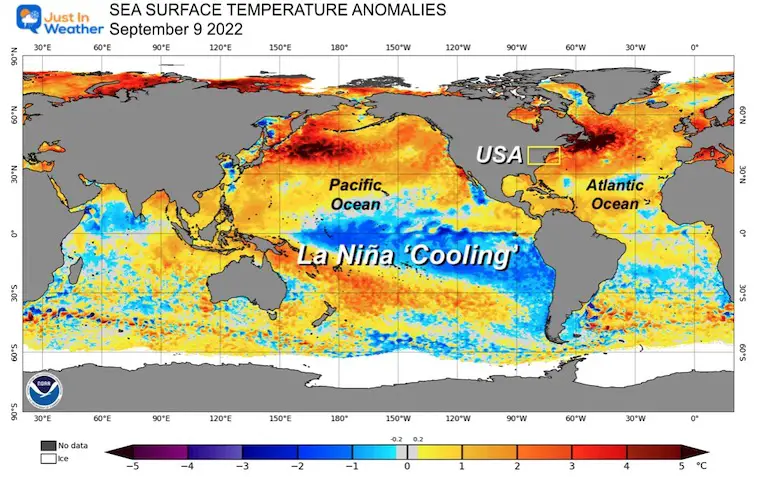
NOAA Synopsis:
La Niña is favored to continue through the Northern Hemisphere winter 2022-23, with a 91% chance in September-November, decreasing to a 54% chance in January-March 2023.
It Has Happened Before:
Most recently, we had a ‘Triple Dip’ La Niña between 1973 to 1976 and 1998 to 2001.
Video: La Niña Explained
From NOAA’s National Ocean Service
Latest Sea Surface Temperatures Animation: Pacific Ocean
Temperature Measurements (cooler= blue or warmer = orange)

Temperature Anomalies (cooler= blue or warmer = orange) than normal

La Niña Winter Weather Pattern
The storm track from the Pacific Ocean tends to take a northern route, diving across the central plains, then up the Ohio Valley. I want to emphasize that this is the NOAA map for a ‘typical La Niña storm pattern. It is not static for the entire season. I put the yellow box over the Mid Atlantic. We are in a region that can be on the edge of the storm track. There are other factors that can shift this south and colder for us, or west and warmer. It is possible to average a warm pattern, and still get a few strong cold storms.
The mention of tornado outbreaks is possible when there is an active storm track and influx of warmer air from the south to interact across the eastern US. The track of the jet stream would dictate which region would be more likely to experience that. The Southeastern US is most likely to be in that zone.
La Niña Winter History: Baltimore
The statements generated from the National Weather Service are not supportive of a snowy winter. This is contradicting what I recently shared from two popular Farmers Almanacs Winter Outlooks.
The caveat is that this is only from 1950 to 2017. There are quality weather records dating back to 1882. But the La Niña years historically are more extrapolated, since that pattern was not thoroughly studied by scientists then. However, within this data there are exceptions and other factors that may not have teamed up together before. I will continue to explore them for my formal outlook.
Important To Note:
La Niña’s are not all the same. The intensity ‘weak’, ‘moderate’, and ‘strong’ can yield different results for our region.
Temperatures
- Warmer than normal 65% of the La Niña Winters.
- Cooler than normal 35% of La Niña Winters.
- Weak La Niña is even chances.
- Moderate La Niña is most likely to bring colder temperatures.
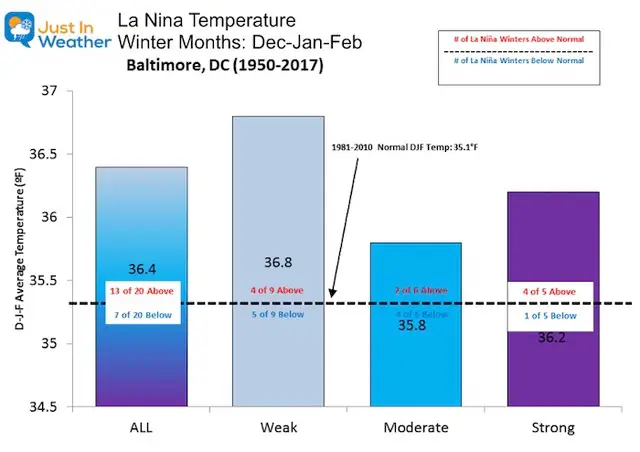
Precipitation
This is total precipitation for rain and snow. Overall there is an even split. But this chart can be confusing. A Moderate La Niña has 4 of 6 times been below average, but the chart has the largest total. This is because when there is an above average pattern, it can be WAY ABOVE AVERAGE to offset the total comparison.
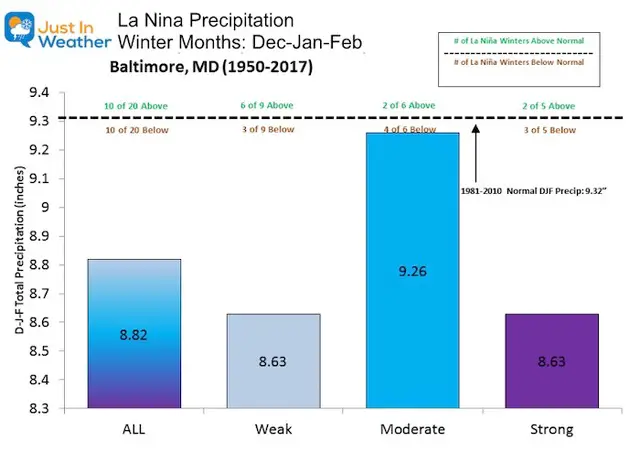
Snowfall
If you have Faith in the Flakes, this might not be what you want to see. But there is a silver lining. While most years show below normal snow, there have been some big exceptions.
1996- January Blizzard was in a La Niña year. This also accounted for most of the snow that winter.
2000 – Most of snowfall that winter was in a 10-day period between January 20 and 30. This included the ‘surprise’ Nor’easter that brought 14.9″ of snow to BWI on January 25.
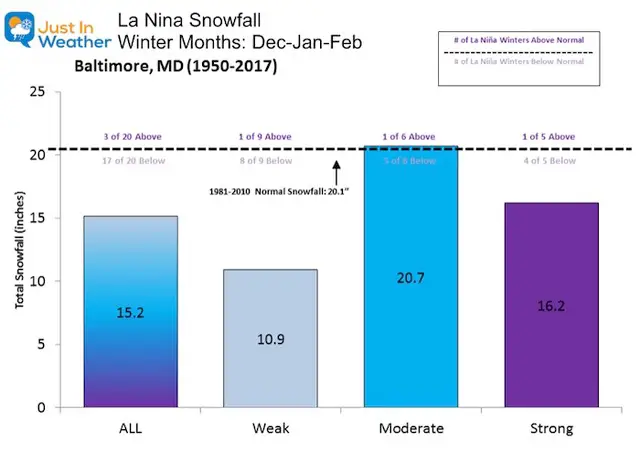
Take Away:
If you don’t want snow, La Niña historically has been your friend.
But if you have FITF, all is not lost. There have been years with big snow storms during a La Niña. Also, there are other elements at play. That is what I explore and try to fit together. This is not scientific law, only one theory. Correlation is NOT causation! It is possible that this winter may have a new combination of global influence to bring us something unprecedented. Besides, these numbers above are only a sample of 77 years. There may have been more supportive data in prior years.
Also See:
Two Farmers Almanacs: A VERY DIFFERENT TAKE
Rainbow Ice Cave In Mt. Rainier A Very Rare Find: Photos And Video
Snowfall AFTER No Tropical Storms In August
Rainbow Ice Cave In Mt. Rainier A Very Rare Find: Photos And Video
Normals And Records: Maryland and Baltimore Climate History
STEM Assemblies/In School Fields Trips Are Back
Click to see more and ‘Book’ a visit to your school
Faith in the Flakes Gear
SNOWSTIX – Available Now




